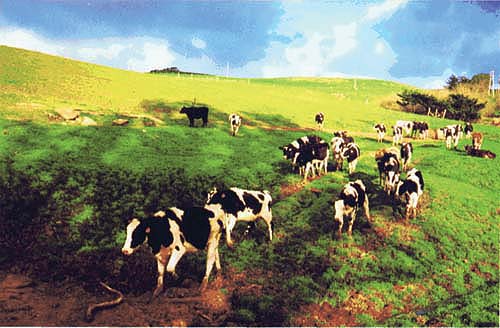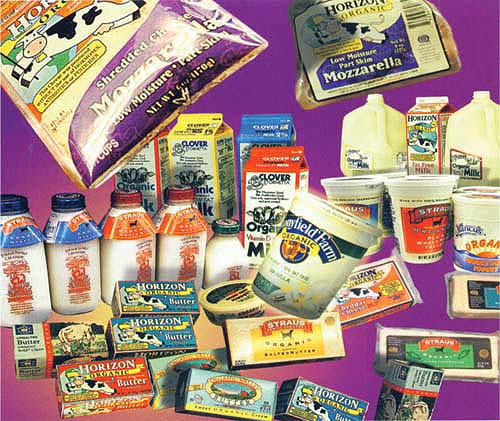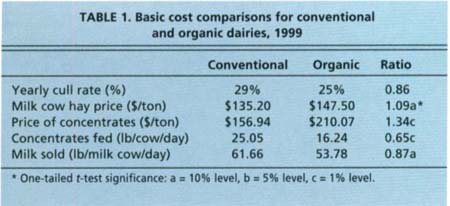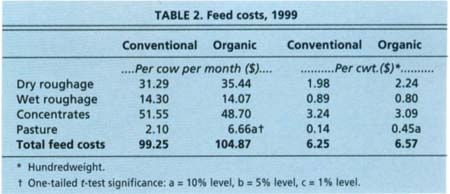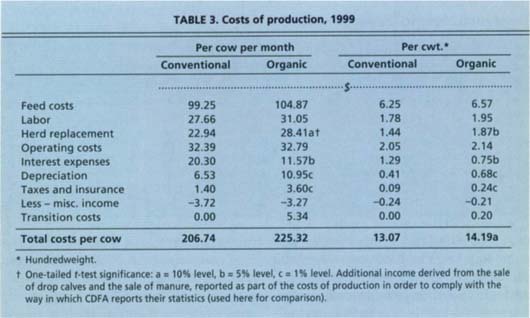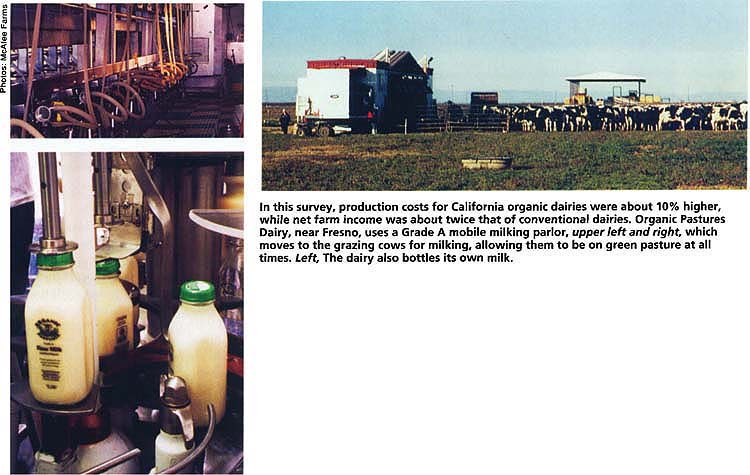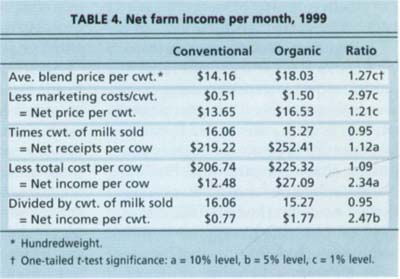All Issues
Survey quantifies cost of organic milk production in California
Publication Information
California Agriculture 56(5):157-162. https://doi.org/10.3733/ca.v056n05p157
Published September 01, 2002
PDF | Citation | Permissions
Abstract
This study measures the cost of organic milk production, and in particular, the differences in cost of production between organic and conventional milk in California. Results show that the total cost of production on a per cow and a per hundredweight basis is about 10% higher for organic producers than for conventional producers in the surveyed regions, and about 20% higher when compared on a statewide basis. The higher costs appear to be due to reduced milk production, higher feed costs, higher average labor costs, significantly higher herd replacement costs and significant transition costs. The higher costs associated with organic milk production are exacerbated to some extent by lower milk yields, and at the same time, are mitigated by the substitution of lower cost pasture for higher priced roughage and concentrate feeds. The higher prices paid for organic milk may more than offset these higher costs compared to their regional, same-sized neighbors.
Full text
Organic farming was one of the fastest growing segments of U.S. agriculture during the 1990s (Greene 2000). The number of organic farmers in the United States has been increasing by 12% per year, and organic agriculture has grown from $78 million in 1980 to about $8 billion today, with projected growth of about 20% a year (Greene 2000). According to studies by the U.S. Department of Agriculture (USDA) Economic Research Service, two organic livestock sectors — eggs and dairy — grew even faster. From 1992 to 1997, the number of registered organic dairy cows increased sharply from 2,265 in 1992 to 12,897 in 1997. Preliminary estimates for 2001 put organic cow numbers near 20,000.
The number of cows raised organically increased sharply during the 1990s, but still represents a very small portion of the dairy industry. Organic dairies rely on ecologically based practices such as pasture feeding, above, at Straus Family Creamery in Marin County. (This photograph and those on the following pages show a sampling of organic dairies in California; these dairies did not necessarily participate in the author's survey.)
If the demand for organic milk and dairy products continues to increase at the pace it has in the past, more conventional dairy producers are likely to consider switching to organic milk production (Dimitri and Richman 2000). The higher prices paid for organic milk are often very attractive for the dairy producer with a smaller herd (Dobbs 1998).
The main goal of this study is to determine the cost of organic milk production in California, and in particular, the differences in production costs between organic and conventional milk, in order to provide information for conventional California dairy producers who might be interested in or considering switching to organic. Much of the difference in cost occurs because of the differences in the management of organic milk cows, many of which are mandatory.
In 1990, the U.S. Congress passed the Organic Foods Production Act to establish national standards for organically produced commodities. Organic farming systems rely on ecologically based practices such as cultural and biological pest management. They exclude the use of synthetic chemicals in crops and prohibit the use of antibiotics and hormones in livestock. Organic livestock production systems attempt to accommodate an animal's natural nutritional and behavioral requirements. Livestock standards address the origin of each animal and incorporate requirements for living conditions, access to the outdoors, feed ration and health care practices suitable to the needs of particular species.
Organic dairying in California
Organic standards in most states are stricter than the rules issued under the 1990 federal act (Duram 1998). In California, organic milk production must conform to the California Organic Foods Production Act (1990), which stipulates — among other things — that producers feed 100% certified organic feed to livestock, not use antibiotics, hormones or prophylactic medications of any kind, and avoid artificial rumen stimulants (see box).
To be approved under USDA's new organic standards, which will be enforced in October 2002, milk must be 100% under continuous organic management for 1 year prior to delivery. Cows producing organic milk must be fed 100% organic feed, and there is zero tolerance for antibiotics. Parasiticides also cannot be used on a regular basis and require 90-day withdrawal times. No genetically modified organisms (GMOs) or their derivatives are allowed, including chymosin (used in cheese making) and recombinant bovine somatotropin (rbST). In addition, cows must have access to pasture.
In 1999, there were about 10 organic dairy producers in California, each with an average of about 200 cows. Milk production per cow varied considerably among organic producers, but appeared to average about 18,000 pounds. This was about 15% less than the 1999 average California conventional production of almost 21,000 pounds per cow. Total production of organic milk in California in 1999 was about 36 million pounds, which was approximately 0.12% of the state's total. However, about 90% of the organic milk produced is used for Class 1, or fluid, purposes. Therefore, organic milk constitutes about 0.5% of the total fluid milk market in California.
Conventional vs. organic dairying
Converting from conventional to organic production is a long-term commitment that needs to be carefully planned and executed to avoid the financial stress that can occur during the transition period. This is particularly true in California where dairying is characterized by large herds, dry-lot intensive feeding of mainly purchased feeds and the use of alternative feeds. The fact that California dairy producers rely on mostly purchased feeds and grow very little of their own (apart from pasture in some regions), means that organic producers must find sources of organic supplemental feed that satisfy the standards. These feeds often cost 25% to 50% more than conventional feeds. However, organic producers rely much more heavily on feeding pasture, and may experience lower milk yields.
Since organic milk producers are prohibited from using drugs, prophylactic medication and growth stimulants or regulators, they are strongly motivated to prevent ailments in the first place, avoiding the complications of sick or ailing cows. Should cows become sick, organic producers use natural medications such as aspirin, garlic and echinacea. Organic producers often scale back milk production, trying not to push the cows as hard as conventional producers might to maximize milk production. As one producer put it, “Cows are like cars. If you push them too hard, they break.” Organic producers also attempt to maintain high standards of comfort to provide a better environment for their cows so that the possibilities of ailments like subclinical mastitis are reduced. This may however lead to slightly higher operating costs.
Organic dairy products, including milk, cheese, butter, sour cream and yogurt, are available in many California supermarkets and grocery stores.
Since cows entering an organic dairy herd must be fed organic feeds at least 1 year prior to the taking of milk, most organic producers find it necessary to raise their own replacements organically, or to purchase organically raised cows. This often adds an additional 10% to 20% to replacement costs.
The 1-year transition period needed to convert to organic is also a significant cost. During this period, organic producers are producing organic milk, but it can only be sold as conventional milk. The costs associated with this transition can only be recovered after the dairy has been certified organic.
Organic dairy producers are usually certified by an accredited certifying agency. In California, the certifying costs can run anywhere from $2,000 to $3,500 annually. Organic dairy producers may also incur higher transportation costs, primarily because the few that exist are spread out over a large area, as well as other small-market access costs.
With a planned reduction in milk production per cow, and assuming feed costs are about 50% of total costs, herd replacement about 15%, and operating costs about 12%, we might conservatively estimate that these additional costs would add about 15% to 20% to the total costs of an organic dairy relative to a conventional operation.
Survey of organic dairies
We identified six organic milk producers who were willing to share their cost of production data for 1999. Three producers were located north of San Francisco in Marin, Sonoma and Mendocino counties (North Bay). The other three producers were located in the northern Central Valley in Stanislaus and Merced counties (North Valley).
A major challenge in this type of research is finding comparable data from organic and conventional producers. Fortunately, the California Department of Food and Agriculture (CDFA) conducts a comprehensive dairy cost production survey, which involves about 400 dairy enterprises in the state's five major producing regions. (CDFA currently does not survey organic dairies.) Each dairy is visited every 2 months, and the data is summarized in the form of costs per cow per month, or costs per hundredweight of milk per month. In this study, we use the 1999 feedback reports, which consist of bimonthly observations of the monthly costs associated with producing milk at each surveyed dairy. Since the organic farms were located in only two of the state's five production regions, we used the feedback reports from those two regions (North Bay and North Valley), and specifically used only the data pertaining to the comparable herd sizes in each region for 1999. Our comparative data set then includes seven dairies from the North Bay, and 20 enterprises from the North Valley. The data from the two regions was combined, annualized and summarized in monthly format. As with other studies of this nature, the small sample size of organic dairies (6) increases the influence of individual operator variability, a factor that is more effectively obscured in the larger conventional dairy sample (27).
The survey of organic dairies followed the format of the CDFA survey as closely as possible to make them as comparable as possible. However, there are differences in the way the surveys were conducted. First, the CDFA survey is conducted bimonthly for each dairy, and the data is reported as monthly costs. In contrast, our survey of organic dairies was carried out only once. Where possible, monthly costs and production statistics were recorded, but some data was only available on an annual basis and converted to monthly data for comparison purposes. Second, we were not able to identify each individual farm included in the CDFA survey, for confidentiality purposes. Therefore the CDFA data does not allow us to annualize each individual farm and perform detailed statistical comparisons between conventional and organic farms. Third, certain data collected and reported by CDFA differed from the data collected from organic enterprises because CDFA uses a number of averaging factors to harmonize their data. For example, labor wage costs collected by CDFA use an average hourly rate for all hired employees in the cost of production area. Interest expenses include a standardized feed inventory and are calculated using an average current rate paid on agricultural loans. Taxes and insurance expenses on owned real and personal property used in the dairy operation are assumed to be the same for all enterprises in a production region. Blend prices received for milk are based on the California Pool Price announcement for the month, and do not include quality or yield bonuses.
Costs of production
Feed
Organic producers must pay significantly higher prices for alfalfa hay and concentrates than conventional producers (table 1). The higher prices paid for organic feed, however, do not necessarily translate into significantly higher feed costs, although they clearly have an influence (table 2). Total feed costs for organic producers are only 5% to 6% higher than for conventional producers, and are not statistically significant, despite the fact that the price of organic hay and organic concentrates are significantly higher. The only statistically significant difference between organic and conventional feed costs occurs in the cost of pasture.
There are several reasons for this. First, while organic hay and concentrate prices are much higher (9% and 34%, respectively), organic producers rely much more on pasture than on purchased feeds. This would account for the statistically significant differences in the costs of pasture. Second, organic producers also appear to feed significantly smaller amounts of concentrates (64%) than do conventional producers (table 1). To reduce the cost of producing organic milk, organic producers rely mostly on substituting pasture for high-priced purchased roughages and concentrate supplemental feeds.
We also found a significant difference between feed costs in the North Bay compared to those in the North Valley. Irrigated pastures in the North Valley allow organic producers to graze cows for 8 to 9 months of the year, while North Bay nonirrigated pastures last only about 4 months.
Labor
Labor costs are expected to be slightly higher in organic operations. For example, human labor is required to hand-weed pastures for thistles and other noxious weeds, since organic producers are prohibited from using herbicides in their fields. However, labor costs for organic dairies in our survey were rather disparate. About half had higher than normal labor costs because they simply paid higher wages. The other half had lower than normal costs because they were small, family-run enterprises that did not engage much additional labor.
Herd replacement
Herd replacement costs are significantly higher for organic producers because replacement heifers must be raised organically, or must be purchased from specialized organic heifer breeders. Our survey results show that replacement costs increase by about 24% on a per cow basis and 30% on a per hundredweight basis (table 3). However, there is some evidence that these increased costs are offset somewhat by the fact that organic producers have a lower rate of culling and replacement. Organic producers do not push their cows as hard to maximize milk production, so their cows remain in the herd longer.
Operating costs
Operating costs include utilities, supplies, veterinary services, repairs and maintenance, hired services and tractors. While some organic operating costs are higher because of a focus on cow comfort, among other things, some costs are also lower. Veterinary and medicine costs, for example, are much lower, while many other operating expenses are about the same. Overall, operating costs on organic and conventional dairies are about the same.
Interest, taxes and insurance
Interestingly, interest expenses on all agricultural loans for organic producers are almost half that for conventional producers. This may be an anomaly in the survey results and some of the difference can be explained by the way CDFA measures these costs.
Conversely, taxes and insurance expenses for organic producers are more than double those of conventional producers. This difference may be explained by a number of factors. The reported tax and insurance expenses for conventional producers may be lower because of the way they are calculated. In the CDFA feedback reports used to calculate the costs of conventional dairying, tax and insurance expenses are reported at a constant $1.88 per cow per month for the North Bay and $1.23 per cow per month for the North Valley, regardless of the size of the enterprise or facilities, or any of a number of other factors. By contrast, tax and insurance expenses reported in the results of the organic survey are actual expenses, and vary from enterprise to enterprise.
Transition to organic
Although we inquired about transition costs to switch from conventional to certified organic production, most organic producers did not specifically account for these costs. To estimate these costs, we assumed that each dairy incurred the same costs as an organic dairy, but received only the conventional price for their milk. We assumed that the cash costs associated with transition from conventional to organic were exactly the same as borrowing the difference in net farm income from a bank, and repaying the loan at 10% interest over a period of 6 years. (Most financial institutions contacted about these rates specified loans ranging from 3 to 8 years, at interest rates ranging from 8% to 12%.) The estimated average cost associated with transition in 1999 was $288.25 per cow, or about $0.92 per hundred-weight of milk. Amortized over a 6-year period at 10%, the cost is $5.34 per cow per month, or about $0.20 per hundredweight. These costs are therefore added into the calculations of total costs (table 3) and for the net farm income calculations below.
In summary, our results found that the total cost of production on a per cow or a per hundredweight basis is about 10% higher for organic producers than for conventional producers. This difference is statistically significant, although the degree of significance varies by particular cost item. Overall, the cost differences appear to be due to reduced milk production, slightly higher feed costs, slightly higher average labor costs, significantly higher herd replacement costs and significant transition costs.
In this survey, production costs for California organic dairies were about 10% higher, while net farm income was about twice that of conventional dairies. Organic Pastures Dairy, near Fresno, uses a Grade A mobile milking parlor, upper left and right, which moves to the grazing cows for milking, allowing them to be on green pasture at all times. Left, The dairy also bottles its own milk.
Net farm income
Net farm income (gross revenues minus total costs of production) for organic farms was more than twice that for conventional dairies on both per hundredweight basis and per cow basis in 1999 (table 4), mostly because of the higher prices paid to organic producers for their milk. Organic producers are paid a fixed price per hundredweight for organic milk and the price does not vary monthly. These prices are determined by the organic creameries that purchase the milk. In contrast, conventional producers are paid a blend price, determined by national markets for butter and cheese, which varies, sometimes dramatically, each month. In previous years, such as 1998, when average blend prices paid for conventional milk were higher, these differences in net farm income would not be as dramatic. In 1999, average blend prices for milk in California were slightly higher than the average for the 8-year period from 1994 to 2001.
Marketing costs for organic producers are much higher because of transportation costs and additional annual costs associated with organic certification. In addition, organic milk yields are lower. These two factors bring gross income (or net receipts) per cow much closer together for the two groups (net receipts per cow are only 16% higher for organic producers than for conventional), emphasizing the fact that the higher prices paid to organic milk producers may be justified on the basis of organic milk supply.
Statewide comparison of costs
Even though the sample of organic farms in the survey is concentrated in the North Bay and North Valley, there are several reasons why it may be appropriate to compare their costs with statewide average costs of milk production. First, organic dairying is practiced in areas of California other than the two areas from which the survey sample was drawn. Because of the differences in costs and management, organic dairying is not necessarily subject to the same regional influences that are characteristic of conventional dairying. Second, when costs of production are used in determining appropriate minimum prices for various classes of conventionally produced milk, the figures used are statewide average costs.
The costs of organic milk production are about 20% higher than average statewide cost of conventional milk production on a per cow basis, and 23% higher on a per hundredweight basis. Labor costs, interest expenses and depreciation costs for statewide conventional milk production are lower than those estimated from the regional feedback reports, while herd replacement costs and operating costs on a per cow basis are higher.
A comparison of net farm income between organic and conventional dairies using statewide average costs shows that, despite the higher prices paid for organic milk, average net farm income is lower for organic production than for conventional milk. Net farm income for organic production on a per cow basis is 75% that of average statewide conventional milk production, and 84% on a net income per hundredweight basis.
Converting to organic production
Organic milk production in California is a very small but rapidly growing segment of the dairy industry. Depending on the continued demand for organic milk and dairy products, organic milk production offers a viable alternative to smaller producers who cannot, or do not wish to compete in the conventional milk market on the basis of economies of size. For the producer contemplating a switch, there are several factors that should be taken into consideration.
First, almost all of the higher costs associated with organic milk production appear to be due to the mandatory rules that circumscribe organic milk production. The most important of these higher costs is the cost of feed, which usually comprises about half of the total costs of milk production. Organic supplementary feeds usually cost 25% to 50% more than conventional feeds. However, most organic dairy producers have managed to overcome what would otherwise be prohibitively higher feed costs by substituting pasture as the main feed.
Second, however, the lower milk yields experienced by feeding pasture have two complementary advantages, apart from lower feed costs. One is that the cows are not pushed to maximize milk production, and therefore tend to remain healthier than their conventional cousins. Another advantage is that the cows tend to remain productive for a longer period of time, reducing the need to cull and replace at the same pace that conventional dairy operations do. This in turn reduces herd replacement costs.
Conventional dairy producers who are considering a transition to organic should take into account important factors such as higher production and feed costs, lowered veterinary and health care costs, and the premium prices they are likely to receive.
Third, other mandatory items that increase the costs of organic dairying such as certification and licensing costs, small-market transportation costs, and the opportunity costs associated with not being able to use conventional medicines on sick or ailing cows, are relatively small in the whole scheme of total costs, However, it should be recognized that these costs do add up and contribute to the overall increased costs of organic dairying. Transition costs are mandatory and they are significant, although for most producers the amortized loan amounts to only 2% to 3% of total annual costs for about 6 years.
Finally, despite the higher costs and lower milk yield, the higher, fixed price per hundredweight that is paid for organic milk does allow organic dairy producers to increase profitability compared to their same-size, regional neighbors, but does not necessarily increase the overall profitability of milk production compared to the statewide average dairy producer.



